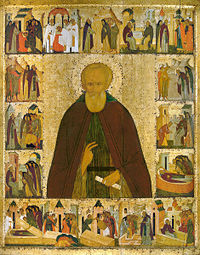Dionisius
Dionisius, Russian: Диони́сий - Dionisy, also Dionisius the Wise, was an icongrapher of the late fifteenth century who was acknowledged as head of the Moscow school of icon painters of his time. He continued in the legacy of Andrei Rublev that reflected the revival of Russian culture during an era when the Russian state was being unified. Dionisius was a contemporary of Raphael, Leonardo, Botticelli, and Durer.

Life
Little is known the life of Dionisius. He was born about the year 1450 into a boyar family and was entered in the paterikon of the St. Joseph Volokolamsk Monastery as Dionisy the Wise. Married, his wife's name was Mary[1]. He had three sons: Theodosius and Vladimir, who also were icon painters, and Andrew. He remained a lay iconographer[2]. The earliest known work by Dionisius was the frescoes of the Cathedral of the Nativity of the Virgin in the St. Paphnutius Borovsk Monastery, about 1470.[3] These frescoes have not survived.
Among the first important commissions by Dionisius was a series of icons for the Dormition Cathedral in the Moscow Kremlin that were executed in 1481. This work was followed by Dionisius' restoration of the Virgin Hodegetria icon that had been destroyed in a fire that ravaged the Kremlin's Ascension Cathedral in 1482[4]. During the last quarter of the fifteenth century, his works included icons for the Volga monasteries of St. Paul Obnorsk, Saviour Priluki, and St. Cyril Belozero that have survived intact. In 1502, Dionisius created with his sons a unique group of frescoes and icons for the Virgin Nativity Cathedral of the St. Ferapont Monastery, the only surviving mural by Dionisius where his artwork has been preserved intact[5].
Dionisius is believed to have died between 1503 and 1508 as his son Theodosius painted the Annunciation Cathedral in the Moscow Kremlin in 1508, an important commission that his father did not take part in, although the date may be as late as 1520.